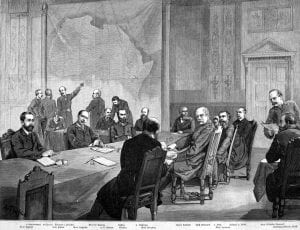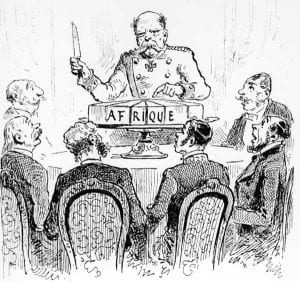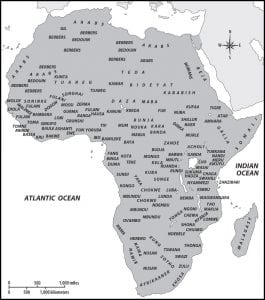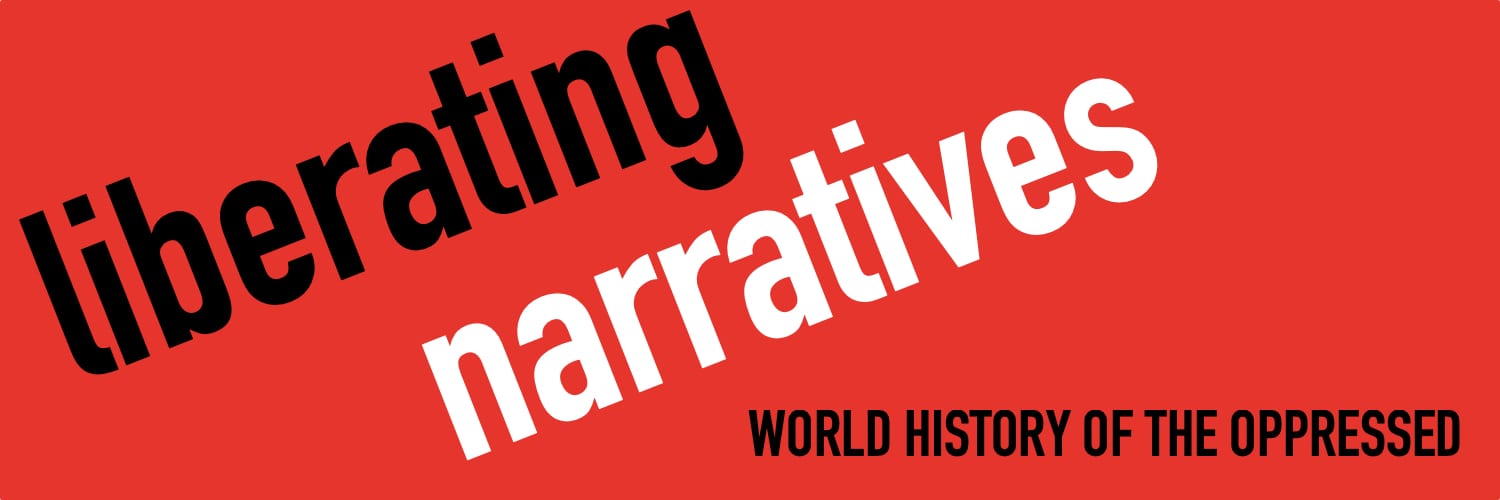Overview: In many world history classes, students learn about the “Scramble for Africa.” In this lesson, students will use visual sources to think about the European colonization of Africa from different perspectives and consider African resistance to European imperialism. Students may also do miniature research projects on African resistance
Background: Students should have already read about the European colonization of Africa in the late nineteenth century in their textbooks.
Time: One class period for the discussion of visuals. The miniature research project will most likely take two additional classes.
Procedures
- Show students the image of the Berlin Conference from Illustrierte Zeitung. Let them know that the image was in a German newspaper at the time of the Berlin Conference. Ask them to make observations about what they see. These observations may include only men in the room, men who look “white” or “European,” and a map of Africa in the background. They may also notice one man in the back left sitting down, wearing a fez, and with his hand over his face. That man was Mehmed Said Pasha, the Ottoman Grand Vizir and representative to the conference. You can find the names to all the people in the picture at the bottom of the image.

Representation of the Berlin Conference (in 1884) where the representatives of the European powers meet.
- Ask students to interpret what the image suggests about the Berlin Conference. Some students will begin to notice that it seems “surprising” or “strange” that there are no people from Africa in the image even though the Conference was about Africa. Some students will also try to figure out why Mehmed Said Pasha has his hand over his face.
- Show students the image of Bismarck slicing a cake labeled Africa. Let them know that it was a French cartoon about the Berlin Conference. Ask them to make observations. Many students will quickly jump from what they observe to what they think the image means. Students might assume that the image was criticizing the conference. In that case, ask them why would the French criticize a conference in which they participated and when the French already had colonies in Africa.

A French cartoon showing German Chancellor Otto von Bismarck slicing up a “African” cake.
- Show two maps of Africa. The first map contains African ethnic and linguistic groups. Ask them what they observe about the maps. The second map contains Africa’s modern political borders and ethnic groups. Again ask them what they observe.

Ethnic and linguistic groups in Africa

African ethnic groups with modern state borders.
- Using the two maps, ask the students to reflect on what the maps suggest about the consequences for African peoples of having Europeans determined the borders for African states. Some students may begin to speculate on how multiple ethnic groups in the same state could be a potential source of conflict or how having an ethnic group split across multiple states could create challenges for that group.
- Show students the map of African resistance to European imperialism. Ask the students what they observe. Some students will notice that most states resisted European imperialism.

African resistance movements in the late nineteenth and early twentieth centuries. From Words Together Worlds Apart.
- Ask students what the multiple resistance movements suggest about the ways in which Africans responded to European colonization.
- Develop a miniature research project in which students learn about these different resistance movements and share their findings with the rest of the class.
- Choose four or more the resistance movements on the map.
- Assign a resistance movement to each group.
- Students use their textbook and the internet to identify the causes of the resistance movement, the events of the rebellion, the outcome, and the consequences of the rebellion.
- Put together a format in which students can organize and present their findings.
- Students groups share their research with the rest of the class and discuss what their findings have taught them about African resistance to imperialism.
You can also read more about the origins of this lesson at Less Scrambling, More Reflecting: Unpacking Simulations of Imperialism and How We can better Teach about the Berlin Conference, the European Colonization of Africa, and African Resistance.
